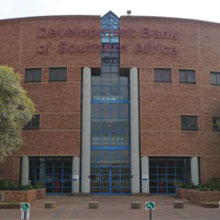 |
| FLIR SR-50 thermal imaging cameras cover the entire perimeter around the DBSA with only four cameras |
The Development Bank of Southern Africa (DBSA) is one of several development finance institutions in South and Southern Africa. The head office of the DBSA is located in Midrand, close to Pretoria, South Africa. The purpose of the DBSA is to accelerate sustainable socio-economic development by funding physical, social and economic infrastructure.
DBSA’s goal is to improve the quality of life of the people of the region. The Bank plays a multiple role of Financier, Advisor, Partner, Implementer and Integrator to mobilise finance and expertise for development projects. Over the next three years, the Development Bank strategy envisages the investment of almost 150 million US$ in South Africa and the deployment of 150 experts to develop and implement infrastructure projects.
Located in South Africa, between Johannesburg and Pretoria, security threats are real for the DBSA. The building contains a lot of valuable material and artwork that a lot of people would like to steal. In order to protect the building, the DBSA recently decided to expand its security network with 4 FLIR Systems SR-50 thermal imaging cameras.
Day and night perimeter security
“We monitor the area around the bank and all entrances continuously with CCTV cameras.”, explains Mr. Jaques du Plessis, Regional Manager Gauteng of Holbert Boikanyo Technologies, a leading provider of integrated security systems in South Africa and responsible for all the security installations at the DBSA.
“During daytime this works perfectly. However, security also needs to perform during the night so I was looking for a good solution for seeing in total darkness. Lighting up a total area, so that you can see in darkness with CCTV cameras, is often not possible.”
Infrared illuminators: An expensive solution
“Initially I was looking at infrared illumination”, Jaques continues. Infrared illuminators beam infrared radiation into the area in front of a camera. The infrared beamers are often placed around the lens of the camera. The infrared radiation is reflected by objects and human beings and converted to an image which can be displayed on a screen.
“Although the initial investment for installing infrared illuminators seemed quite reasonable, I quickly find out that it actually is an expensive solution. Replacing the infrared beamers is a costly exercise. Furthermore, we needed a good range performance. This means we needed to install infrared illuminators with powerful beamers which consume a lot of power. This would dramatically increase the Total Cost of Ownership.”
Thermal imaging cameras: Low total cost of ownership
“I did some research for other solutions and got in contact with Mr. Tinus Diedericks of Timeless Technologies, FLIR Systems distributor in South Africa. Mr. Diedericks came to the site to do a demonstration. I was impressed with the images the thermal cameras were producing in total darkness and investigated more.”
"They have an excellent range performance allowing detection of a man at a distance of about 800 metres. They are overlooking the areas next to the building and also the parking lot”, says Mr. Jaques du Plessis, RM Gauteng of Holbert Boikanyo Technologies |
“I found out that although the initial investment in thermal imaging cameras might be a bit higher, they would pay for themselves in the long run. Thermal imaging cameras do not consume a lot of power and since they contain an uncooled Vanadium Oxide detector which does not contain any moving parts at all, they are maintenance free. Once in operation they are good for several years, hassle free, continuous operation.”
FLIR Systems SR-50 thermal imaging cameras
“After studying the perimeter at the DBSA, we decided to install 4 FLIR Systems SR-50 thermal imaging cameras. They have an excellent range performance allowing detection of a man at a distance of about 800 metres. They are overlooking the areas next to the building and also the parking lot.”
“In order to increase our situational awareness, we decided to mount the thermal imaging cameras on a pan/tilt. This way we can point them to whatever direction we want. It also allowed us to cover the entire perimeter around the DBSA with only four cameras. We have installed a FLIR Systems SR-50 at every corner of the building.”
“We can not only use them during night time but they are very useful during daytime as well. They can see through light fog and are not affected by glare from the sun.”
Easy installation
“The thermal imaging cameras were really simple to install”, continuous Mr. Plessis. "We display the images of the four SR-50 thermal imaging cameras on one large display in the control room. From the control room we can turn the pan/tilt, on which the SR-50’s are installed, in every desired direction. If something unusual is detected we send out a walking patrol with dogs to the area where there is unusual activity.”
“The next step at the DBSA is to install a Video Motion Detection (VMD) system. The thermal imaging cameras produce perfect images for this. If motion is detected, an alarm will go off automatically.”
Future projects
“The FLIR Systems thermal imaging cameras are doing extremely well. We have had no problems with them whatsoever so far and are very impressed with their performance.”
“Holbert Boikanyo Technologies is a leading provider of integrated security systems in South Africa. We are heavily involved in installing security systems for estates but also for industrial sites, mines and other institutions like the DBSA. Now that we have seen and experienced the power of thermal imaging cameras, we will definitely propose them to other customers as well”, concludes Mr. Plessis.

















